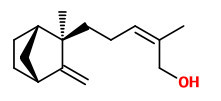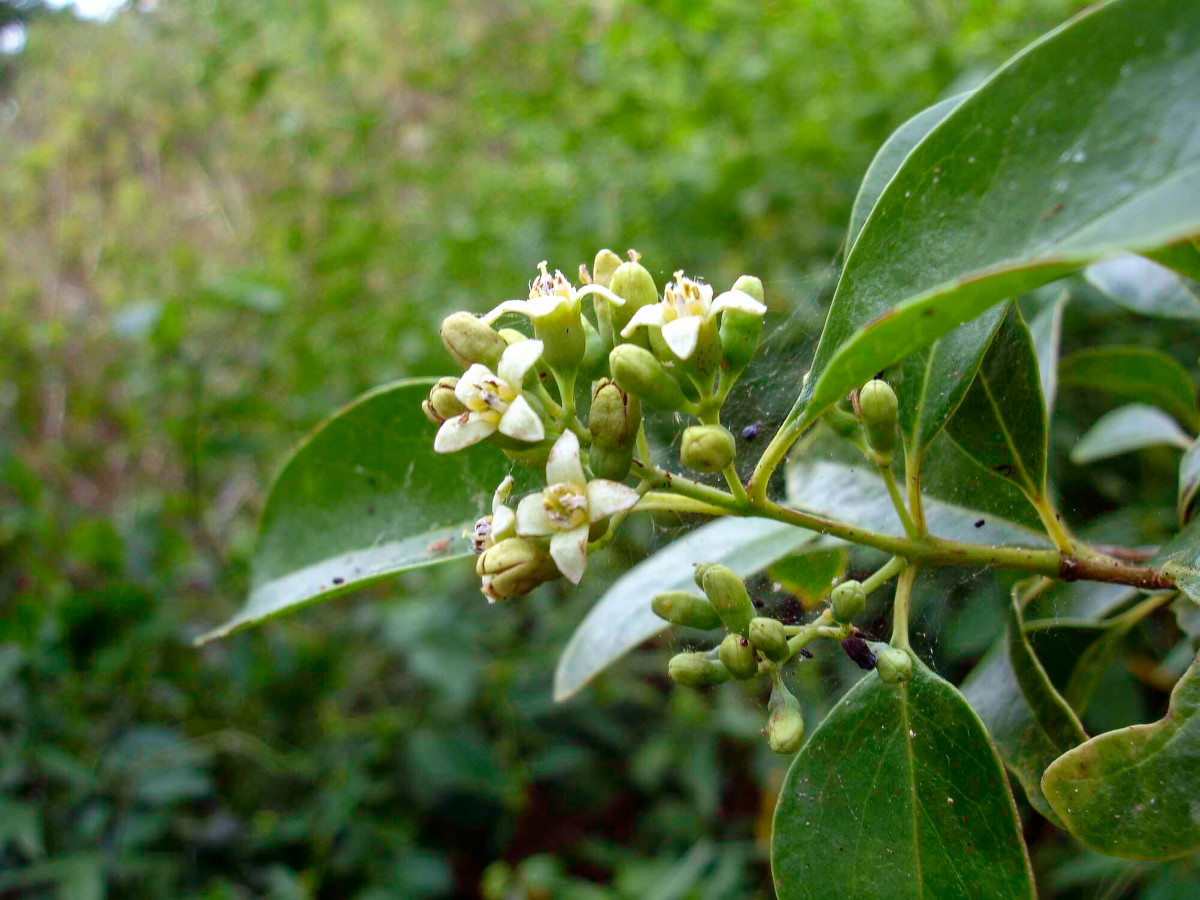Santalum austrocaledonicum Vieill. - Santalaceae - New Caledonia sandalwood, Neukaledonsiches Sandelholz
Hemiparasitic evergreen shrub or small tree, 2-10m tall, native in New Caledonia and Vanuatu; bark rough,
grey to reddish-brown, longitudinally fissured; heartwood fragrant, yellowish to brownish.
„Heartwood or root shavings of S.austrocaledonicum var.austrocaledonicum were hydrodistilled to yield 1-2% of a pale yellow oil… New Caledonian sandalwood oil is long-lasting, has little or no particular top note and smells soft, sweet-woody, nutty, animalic-balsamic, but is weaker and less radiant than its East Indian counterpart… (Z)-α-santalol (38.2%), (Z)-β-santalol (18.2%), (Z)-trans-α-bergamotol (9.9%), (Z)-lanceol (9.1%), and epi-β-santalol (3.8%) were detected as main constituents… GC-olfactometry revealed, that iso-β-bisabolol, a new odor active sandalwood trace constituent, having a strong floral, muguet-like, very pleasant smell was also present in the oils from New Caledonia. Both oil composition and odor impression of New Caledonian sandalwood oil are very reminiscent of East Indian sandalwood oil. One significant difference was the high amount of (Z)-lanceol (9.1%) in S.austrocaledonicum var.austrocaledonicum.“
[Braun, N. A., Meier, M., & Hammerschmidt, F. J. (2005). New Caledonian Sandalwood Oil-a Substitute for East Indian Sandalwood Oil?. Journal of Essential Oil Research, 17(5), 477-480]
Heartwood essential-oil of Santalum austrocaledonicum from eleven populations on seven islands of Vanuatu showed large phenotypic variation.
„The concentrations of the four major essential-oil constituents (α-santalol, β-santalol, (Z)-β-curcumen-12-ol, and cis-nuciferol) of alcohol-extracted heartwood exhibited at least tenfold and continuous tree-to-tree variation. Commercially important components α- and β-santalol found in individual trees ranged from 0.8-47% and 0-24.1%, respectively, across all populations, and significant (P<0.05) differences for each were found between individual populations. The Erromango population was unique in that the mean concentrations of its monocyclic ((Z)-β-curcumen-12-ol and cis-nuciferol) sesquiterpenes exceeded those of its bi- and tricyclic (α- and β-santalol) sesquiterpenes.“
[Geographic and Phenotypic Variation in Heartwood and Essential‐Oil Characters in Natural Populations of Santalum austrocaledonicum in Vanuatu., Page, T., Southwell, I., Russell, M., Tate, H., Tungon, J., Sam, C., Leakey, R.R., Chemistry & biodiversity, 7(8), 2010, 1990-2006]
 (Z)-α-santalol (woody, cedarwood) |  (Z)-β-santalol (typical sandalwood, milky, urinous) |
S. austrocaledonicum var. glabrum Hürl. - native to New Caledonia, Loyalty Islands:
leaves glabrous, leaf blade usually more than 3.5 × 1.5 cm, petiole 7-13mm, blade adaxial surface not glaucous and bluish in color; interstaminal disk lobes wide; seed usually more than 9 × 7.5 mm; globose.
The essential oil of Santalum austrocaledonicum var.glabrum is considered as a possible substitute for Indian
sandalwood oil (Santalum album). Organoleptic evaluation showed that the Loyalty essential oil is lighter and less milky, less woody but more animal and masculine than Indian sandalwood. GC showed (Z)-α-santalol (44-47%) and (Z)-β-santalol (19-21%), meeting ISO Standard 3518: 2002 for S.album oils. Another main component was (E)-lanceol (8-14%).
[Reinstatement of the Loyalty Islands Sandalwood, Santalum austrocaledonicum var. glabrum (Santalaceae), in New Caledonia., Butaud, J.F., PhytoKeys, (56), 2015, 111] https://www.ncbi.nlm.nih.gov/pmc/articles/PMC4611752/

Santalum austrocaledonicum, Poum, New Caledonia (2006) © juju98 CC BY-SA 4.0 inaturalist.org